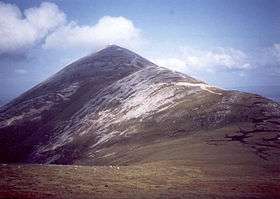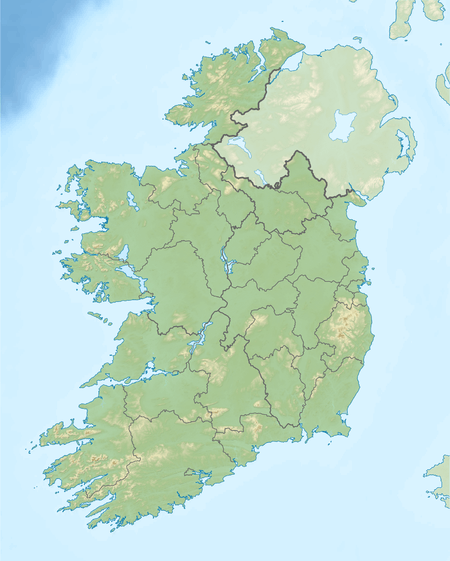Croagh Patrick
| Croagh Patrick | |
|---|---|
|
Cruach Phádraig The Reek | |
 | |
| Highest point | |
| Elevation | 764 m (2,507 ft) |
| Prominence | 640 m (2,100 ft) |
| Listing | Marilyn, Hewitt |
| Coordinates | 53°45′34″N 9°39′30″W / 53.7595°N 9.6584°WCoordinates: 53°45′34″N 9°39′30″W / 53.7595°N 9.6584°W |
| Naming | |
| Translation | (Saint) Patrick's Mountain (Irish) |
| Geography | |
 Croagh Patrick | |
| OSI/OSNI grid | L906802 |
| Topo map | OSi Discovery 30, 31, 37 or 38 |
| Climbing | |
| Easiest route | Hike |
Croagh Patrick (Irish: Cruach Phádraig, meaning "(Saint) Patrick's Stack"),[1] nicknamed the Reek,[2] is a 764 metres (2,507 ft) mountain and an important site of pilgrimage in County Mayo, Ireland. It is 8 kilometres (5 mi) from Westport, above the villages of Murrisk and Lecanvey. It is the third highest mountain in County Mayo after Mweelrea and Nephin. It is climbed by pilgrims on Reek Sunday every year, which is the last Sunday in July. It forms the southern part of a U-shaped valley created by a glacier flowing into Clew Bay in the last Ice Age. Croagh Patrick is part of a longer east-west ridge; the westernmost peak is called Ben Gorm.
Name
Croagh Patrick comes from the Irish Cruach Phádraig meaning "(Saint) Patrick's stack". It is known locally as "the Reek", a Hiberno-English word for a "rick" or "stack".[3] In pagan times it was known as Cruachán Aigle or Cruach Aigle, being mentioned by that name in sources such as Cath Maige Tuired,[4] Buile Shuibhne,[5] The Metrical Dindshenchas,[6] and the Annals of Ulster entry for the year 1113.[7] Cruachán is simply a diminutive of cruach "stack", but it is not certain what Aigle means. It is either from the Latin loan aquila "eagle" (more usually aicile or acaile)[8] or a person's name.[6][9] In addition to its literal meaning, cruach in the pagan name may also have some connection with Crom Cruach.
The Marquess of Sligo, whose seat is nearby Westport House, bears the titles Baron Mount Eagle and Earl of Altamont, both deriving from alternative names (Cruachán Aigle; high mount) for Croagh Patrick.[10]
Pilgrimage
On the last Sunday in July, thousands of pilgrims climb Croagh Patrick in honour of Saint Patrick who, according to tradition, fasted and prayed on the summit for forty days in the year 441.[11] Masses are held at the summit, where there is a small chapel. Some climb the mountain barefoot, as an act of penance,[12] and carry out 'rounding rituals', in which they pray while walking sunwise around features on the mountain. It is likely that the pilgrimage pre-dates Christianity and was originally a ritual associated with the festival of Lughnasadh.[13][14] However, the sheer volume of visitors has led to erosion and made the mountain more dangerous for climbers.[15]
Summit chapel
There had been a chapel on the summit since the 5th century,[16] called "Teampall Phádraig". An archaeological excavation in 1994 found the remains of a foundation at the summit. In 824 the Archbishops of Armagh and Tuam disagreed as to who had jurisdiction.[17]
A small chapel was built on the summit and dedicated on 20 July 1905. During the pilgrimage on 31 July 2005, a plaque commemorating its centenary was unveiled by Michael Neary, the Archbishop of Tuam.
It was decided in 2005 to open the church every day during the summer, rather than only on holy days. Mass is celebrated in the church on Reek Sunday and on 15 August. It is opened by information guides.
Gold discovery
A seam of gold was discovered in the mountain in the 1980s: overall grades of 14 grams of gold per tonne (0.45 oz gold per ton) in at least 12 quartz veins, which could produce 700,000 tonnes (770,000 short tons) of ore — potentially over 300,000 troy oz of gold (worth over €360m). However, due to local resistance by the Mayo Environmental Group headed by Paddy Hopkins, the Mayo County Council decided not to allow mining.[18]
Gallery
 Distant view of mountain from Westport
Distant view of mountain from Westport Notice at base about Stations for Catholic climbers, with statue of Saint Patrick
Notice at base about Stations for Catholic climbers, with statue of Saint Patrick Upper slopes of mountain
Upper slopes of mountain St. Patrick's Oratory at the summit
St. Patrick's Oratory at the summit St. Patrick's Bed at the summit
St. Patrick's Bed at the summit Cairn near summit with view of Clew Bay and Mayo mountains
Cairn near summit with view of Clew Bay and Mayo mountains Chapel at the summit of Croagh Patrick
Chapel at the summit of Croagh Patrick
See also
References
- ↑ Croagh Patrick Placenames Database of Ireland. Retrieved: 2013-07-31.
- ↑ Croagh Patrick, Taifid chartlainne (archival records) Placenames Database of Ireland. Retrieved: 2013-07-31.
- ↑ New Shorter Oxford English Dictionary, CD edition 1997, Oxford University Press, Oxford 1973, 1993, 1996.
- ↑ CELT: The Second Battle of Moytura (translation) - Irish
- ↑ CELT: Buile Shuibhne (translation) - Irish (Cruachán Oighle)
- 1 2 CELT: The Metrical Dindshenchas, 88 Cruachán Aigle (translation) - Irish
- ↑ CELT: Annals of Ulster 1113 (translation) - Irish
- ↑ Entry for aicil at eDIL
- ↑ Old-Irish-L: Cruachan Aigle 31 Jul 2002
- ↑ George Edward Cokayne ed. Vicary Gibbs, The Complete Peerage, volume I (1910) p. 113.
- ↑ "In imitation of the great Jewish legislator on Sinai, he spent forty days on its summit in fasting and prayer, and other penitential exercises." Catholic Encyclopedia
- ↑ "The History of Croagh Patrick from the Croagh Patrick Visitor Centre - Teach na Miasa". www.croagh-patrick.com. Retrieved 2016-11-30.
- ↑ Harbison, Peter. Pilgrimage in Ireland: The Monuments and the People. Syracuse University Press, 1995. p.70
- ↑ Monaghan, Patricia. The Encyclopedia of Celtic Mythology and Folklore. Infobase Publishing, 2014. p.104
- ↑ Kieran Cooke (11 October 2015). "The holy mountain that's become too popular". BBC news. Retrieved 11 October 2015.
- ↑ McDonald, Michael. "Croagh Patrick." The Catholic Encyclopedia. Vol. 4. New York: Robert Appleton Company, 1908. 21 Feb. 2014
- ↑ Haggerty, Bridget. "He Came To Mock - But Stayed to Pray", Irish Culture and Customs
- ↑ "Obituary Paddy Hopkins". The Mayo News. 30 July 2013. Retrieved 10 September 2013.
Bibliography
External links
| Wikimedia Commons has media related to Croagh Patrick. |
